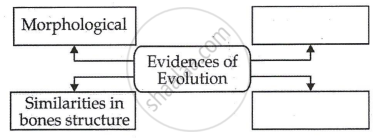Advertisements
Advertisements
प्रश्न
Give a scientific reason.
Morphological evidences suggest that dog, sheep and wolf have a common origin.
उत्तर
The similarities between dog, sheep, and wolves' jaw structures, eye positions, nare structures, and other anatomical features show that these three animals share a common ancestor.
APPEARS IN
संबंधित प्रश्न
Mammals : _________ : : Amphibia : Fishes
State a reason for the increased population of dark coloured moths coinciding with the loss of lichens (on tree barks) during industrialization period in England.
Four students A, B, C and D reported the following set of organs to be homologous. Who is correct ?
(A) Wings of a bat and a butterfly
(B) Wings of a pigeon and a bat
(C) Wings of a pigeon and a butterfly
(D) Forelimbs of cow, a duck and a lizard
Explain with an example for the given, how the following provides evidence in favor of evolution in organisms :
Fossils
How do homologous organs help in providing evidence for organic evolution?
Human tailbone is a vestigial organ. Explain.
The forelimbs of a frog, a bird and a man show the same basic design (or basic structure) of bones. What name is given to such organs?
The wings of a housefly and the wings of a sparrow are an example of :
(a) analogous organs
(b) vestigial organs
(c) respiratory organs
(d) homologous organs
X, Y, and Z are three animals. The animal X can fly but animal Y can only run on ground or walls. The forelimbs of animals X and Y have the same basic design but they are used for different purposes such as flying and running respectively. The animal Z became extinct an long time ago. The study of fossils of Z tells us that it had some features like those of X and some like those of Y. In fact, Z is said to form a connecting link in the evolutionary chain of X and Y.
(a) What could the animals X, Y and Z be?
(b) What name is given to the forelimbs like those of X and Y which have the same basic design but different functions?
(c) Name one feature in which Z resembled X.
(d) Name one feature in which Z resembled Y.
(e) Which is the correct evolutionary chain involving X, Y and Z : X → Z → Y or Y → Z → X?
The organs P and Q of two animals have different structures but similar functions. On the other hand, the two organs R and S of two other animals have the same basic structure but different functions.
(a) What are the organs like P and Q known as?
(b) Name the organs like P and Q. Also name the animals which have such organs.
(c) What are the organs like R and S called?
(d) Name the organs like R and S. Also name the animals which have such organs.
Select a set of homologous organs from the following:
(A) Wings of a bat and wings of a butterfly
(B) Wings of a pigeon and wings of a bat
(C) Wings of a butterfly and wings of a pigeon
(D) Forelimbs of a duck, forelimbs of a cow and forelimbs of a lizard
Write short notes based upon the information known to you.
Connecting link
Answer the following question.
Wisdom teeth : Vestigial organs :: Lungfish : ....................
Explain any three molecular (genetic) evidences in favour of organic evolution.
Define fossil.
Differentiate between connecting links and the missing links.
Answer the following question:
What are homologous structures? Give an example. Is it necessary that homologous structures always have a common ancestor? Justify your answer.
Very short answer question:
What is vestigeal organ?
Name the parts shown in the diagram.
Human jaw

Explain any five types of evidence that support the theory of evolution.
A human hand, a front leg of a cat, a front flipper of a whale and a bat’s wing look dissimilar and adapted for different functions. What is the name given to these organs?
Palaeontological evidence for evolution refers to the ______.
Study of fossils is ______.
Which is not a vestigial organ in a man?
Organs having similar functions but different origin and development are known as:
Which of the following is used as an atmospheric pollution indicator?
Fossils are generally found in ______.
What are we referring to? When we say 'simple organisms' or 'complex organisms'.
How do we compute the age of a rock?
The evolutionary story of moths in England during industrialisation reveals, that 'evolution is apparently reversible'. Clarify this statement.
You have studied the story of Pepper moths in England. Had the industries been removed, what impact could it have on the moth population? Discuss.
Complete the following chart:

Find odd one out:
As shown in figure below some organisms that share a common ancestor have features that have different functions, but similar structures.

These are known as ______. Give example.
Complete the following conceptual picture:

Give examples of homologous organs and analogous organs in plants.
